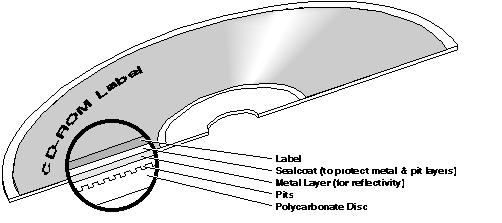
|
Go To | CD-ROM Storage |
CD-ROM Lifetime |
I thought CDs were indestructible?
While CD-ROM is one of the most durable data storage devices ever invented,
they are not indestructible. To understand what can affect the quality
and lifetime of a CD-ROM disc, we first need to look at how they are put
together. All CDs are made up of several layers, as shown in this CD-ROM
construction diagram. The thickest layer, sometimes called the substrate,
is molded from polycarbonate plastic. (Yes, this is the same plastic used
for bulletproof windows, although much thinner.)

The top of this substrate is where the pits are actually molded into. However,
if drawn to scale, the pits would hardly be discernible because although
the substrate is 1.2mm thick, the pits are only about 1/1000 that deep!
On top of the pit surface, a thin layer of metal is deposited. This is
what gives the disc its shiny look. This metal is most often aluminum,
but some manufacturers use alloys to make the discs look golden, or even
use actual gold. This layer is also very thin, but must be thick enough
to reflect most of the laser light back to the drive so the discs can be
read reliably. On top of the metal, a sealcoat layer is added to protect
the metal from damage such as scratches and corrosion from the outside
air. The disc label is then silk screened directly on top of the protective
coat, completing the process.


Copyright 1996 Imation. All rights reserved.













|




















